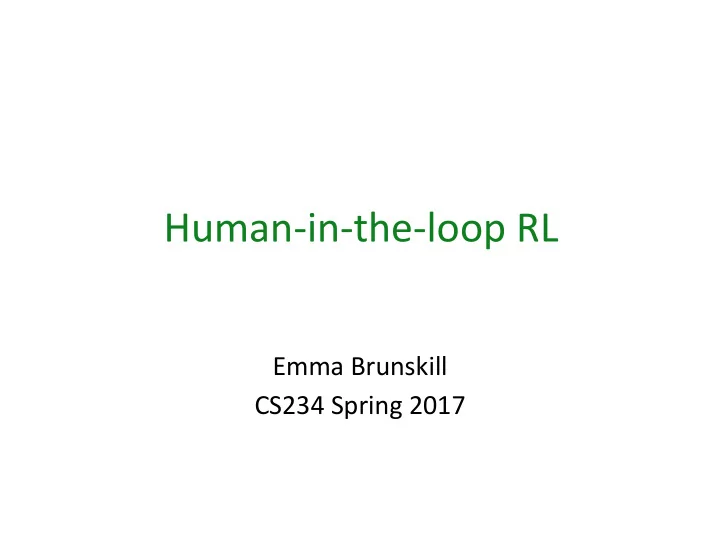

Human-in-the-loop RL Emma Brunskill CS234 Spring 2017
From here … . to education, healthcare …
w/Karan Goel, Rika Antonova, Joe Runde, Christoph Dann, & Dexter Lee
Setting ● Set of N skills ○ Understand what x-axis represents ○ Estimate the mean value from a histogram ○ ... ● Assume student can learn each skill independently ● Policy is a mapping from the history of prior skill practices & their outcomes to whether or not to give the student another practice problem ○ E.g. (incorrect, incorrect, incorrect) → give another practice ○ (correct,correct) → no more practice ● Use a parameterized policy to characterize the teaching policy for each skill ● Reward is a function of the student’s performance on a post test after the policy for each skill says “no more practice” and how much practice gave
Initial Work: Bayesian Optimization Policy Search Figure from Ryan Adams
Learning to Teach Goal: Should Learn Policy That Maximizes Expected Student Outcomes Bayesian Optimization with a Gaussian Process Create new π = f ( θ i ) training point [ f ( θ i ),R] Teach a learner with policy π in environment for T steps, observe reward R
Reward Signal? ● Balance post test performance with amount of practice needed ● p s =Performance on skill s, ● p = Post test performance across all skills, ● l = # practices for skill s
During Policy Search Tutoring System Stopped Teaching Some Histogram Skills
Reward Signal: Post Test / # Problems Given
During Policy Search Tutoring System Stopped Teaching Some Histogram Skills • No improvement in post test → system had learned that some of our content was inadequate so best thing was to skip it! • Content (action space) insufficient to achieve goals
Humans are Invention Machines New actions New sensors
Invention Machines: Creating Systems that Can Evolve Beyond Their Original Capacity To Reach Extraordinary Performance New actions New sensors
Problem Formulation • Maximize expected reward • Online reinforcement learning • Directed action invention – Where (which states) should we add actions at? Mandel, Liu, Brunskil & Popovic, AAAI 2017
Related Work • Policy advice / learning from demonstration • Changing action spaces – Almost all work is reactive, not active solicitation Mandel, Liu, Brunskil & Popovic, AAAI 2017
Online reinforcement Active Domain (Action learning Space) Adaptation Mandel, Liu, Brunskil & Popovic, AAAI 2017
Requesting New Actions Current New action action set Mandel, Liu, Brunskil & Popovic, AAAI 2017
Expected Local Improvement Prob. human Improvement in value at state gives you action s if add in action a h a h for state s Mandel, Liu, Brunskil & Popovic, AAAI 2017
V(s) given Probability get a new action current action set that will increase V(s) Unknown! Mandel, Liu, Brunskil & Popovic, AAAI 2017
What to Use for • Be optimistic (MBIE, Rmax, … ) • Why? – Don’t need to add in new actions if current action set might yield optimal behavior – Avoids focusing on highly unlikely states Mandel, Liu, Brunskil & Popovic, AAAI 2017
Probability of Getting a Better Action • Don’t want to ask for actions at same state forever (maybe no improvement possible) • Model prob of a better action as • Chance of better action decays w/ # of actions Mandel, Liu, Brunskil & Popovic, AAAI 2017
Simulations • Large action task* (Sallans & Hinton 2004) – 13 states – 273 outcomes (next possible states per state) – 2 20 actions per state • At start each s has single a (like default π) • Every 20 steps can request an action – Sample action at random from action set for s – Compare ELI vs Random s vs High freq s Mandel, Liu, Brunskil & Popovic, AAAI 2017
*With best choice of algorithm for choosing current value ELI* Freq Random Mandel, Liu, Brunskil & Popovic, AAAI 2017
Mostly Bad Human Input Mandel, Liu, Brunskil & Popovic, AAAI 2017
• New actions = new hints • Learning where to ask for new hints
Summary ● Can use RL towards personalized, automated tutoring ○ More applications next week! ● Can create RL systems that evolve beyond their original specification ○ Not limited by original state/action space ○ Help humans-in-the-loop prioritize effort ○ Towards extraordinary performance
Recommend
More recommend